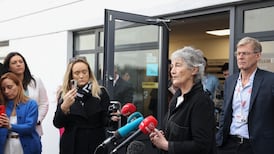Lee Keegan will not play for Mayo this weekend as he continues to recover from the clash of heads he had with Cork defender Eoin Cadogan during Sunday's Allianz League match in Páirc Uí Rinn. While neither the Mayo management nor its medical team were willing to comment any further than their statement of Sunday night, it was confirmed that the three-time All Star will sit out Saturday's game against Dublin in Castlebar.
Keegan, who was captain for the day against Cork, continued playing for a further 10 minutes after his collision with Cadogan. It is believed that the prompting for the Mayo statement of Sunday night in which they accepted that they were mistaken in allowing Keegan remain on the pitch came directly from team doctor Seán Moffatt.
Moffatt has received support from Dr Kevin Moran, the Donegal team doctor and consultant surgeon who sits on the GAA's Medical, Scientific and Welfare Committee. Having watched the game on television, Moran's view is the incident lays bare how difficult it is for any team doctor to make an on-the-spot determination when it comes to concussion.
“Obviously, in retrospect, the player should have been taken off immediately,” says Dr Moran. “No question about that. Once the Cork player was taken off immediately and the Mayo player wasn’t, I suppose it highlighted it even more. I only saw it on television but it seemed to me clearly that Lee Keegan did not want to leave the field. You could see him protesting both with Seán Moffatt and with Maurice Deegan.
“Again, it’s easy to be wise in retrospect but in that situation, Seán should have gone to the manager and said, ‘I’m not happy, the player needs to come off the field.’ And then it becomes the manager’s responsibility. Those are the guidelines from Croke Park.
"There is no question in my mind here of Sean Moffatt having been negligent. Absolutely none. His major concern has always been player welfare. I have huge sympathy for him and there but for the grace of God go all of us who are team doctors. He came out and put his hands up and said he should have taken him off. I think that was very honest and honourable of him to do that."
If ever a case showed the complexities involved in judging whether a concussion has taken place, Keegan’s is it. Referee Maurice Deegan immediately stopped play once Keegan’s attempted shoulder on the onrushing Cadogan caused them to clash heads and left them both flat out on the ground. This meant that both the Cork and Mayo medical teams were with their players just 15 seconds after the collision.
Moffatt was able to get Keegan onto his knees to check his eyes within 40 seconds of the collision and Keegan was back on his feet within 55 seconds of the impact. Whereas Cadogan got up gingerly and was slightly shaky on his feet, Keegan had no trouble standing or walking straight away. He was also able to argue his case for being allowed to continue. All of these factors fed into Moffatt’s decision to leave him on the pitch.
Moffatt isn’t just any team doctor. When a joint Oireachtas committee investigating concussion in sport called various sporting bodies in front of it in October 2014, Moffatt was the chosen expert who the GAA put up to represent them in his role as technical adviser on medical matters. In his remarks to the committee, Moffatt was clear as to the how the association should approach concussion.
“The GAA has tried to have the same uniform message for both elite and club players,” he said. “As we have been coming from a low base since 2007, it is very much based on education, whereby if one recognises a sign or symptom of concussion, the message is ‘if in doubt, take them out’.”
Absent further comment from Dr Moffatt, it can only be inferred that in that moment there was nothing in Keegan’s reactions to make the team doctor doubt him. Keegan’s next involvement takes place just a minute after the resumption of play when he makes a quick intervention to punch a 50/50 ball away from Mark Collins. It would have been difficult for anyone to argue that there was a sign of concussion in his play at that point. It’s only when he goes down on his haunches a full nine minutes later that it becomes obvious that something is wrong.
“The very important point to take into account is the speed in which he was back on his feet,” says Dr Moran. “If you have a player who is back on his feet that quickly and who hasn’t had a previous incident with concussion, it might have been reasonable in the circumstances to see what happened to him over the next few minutes. But it is only possible for the doctor on duty to make that determination.
“You go to a doctor with an injured leg and he can do an x-ray to say whether it’s broken or not. None of that exists here. You are going on the guidelines that we have. There is this idea that you can do a five-minute SCAT-3 test on the sideline and diagnose concussion – you can’t. That test is supportive but it’s no more than that.
“Ultimately, it’s a clinical decision and I can see how Seán ended up at his assessment. The number of seconds that he was on the ground is important, so is the fact that he was up and he was arguing his case. I can easily see how it could have happened.”












